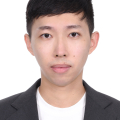Fundamentals of Light Emitting Diodes
Our work on fundaments of group III nitrides includes understanding the impact of natural alloy disorder on carrier localization, transport, and recombination. In our earlier work with Professor Yuh-Renn Wu (National Taiwan University), we showed that natural alloy disorder in GaN-based LEDs is responsible for the low operating voltage of today’s LEDs, via percolative transport through barriers, and enhanced recombination rates via locally increased carrier density in naturally occurring In-rich regions in InGaN QWs [link]
Our current work is built on the new Landscape Localization (LL) theory developed by Professors Marcel Filoche (Ecole Polytechnique, Paris) and Svitlana Maybaroda (University of Minnesota). LL theory is built on solving an ordinary differential equation Hu = 1 with the same kinetic and potential energy operators in H as the Schrodinger equation. The landscape function can be used to define an effective potential W=1/u. This approach is numerically efficient and can be used in practical 3D device simulations that include all effects of alloy disorder [link, link, link]. Ongoing work is focused on improving the methodology and testing the predictions against well defined experimental test structures.
Our work on inefficiency in LEDs is focused on understandanding the mechanisms of non-radiative recombination. Using the technique of electroemission spectroscopy, in close collaboraton with Professors Claude Weisbuch (UCSB and Ecole Polytechnique), Jacque Peretti and Lucio Martinelli (Ecole Polytechnique), we made the first direct observation of Auger-generated hot electrons from electron-electron-hole (eeh) nonradiative recombination [link]. Ongoing work is focused on refining the experiments [link], quantification of the Auger rate, understanding the origin of thermal droop and the green gap. We have recently developed a photomodulation technique that can be used to directly measure the added current in forward biased diodes that is associated with Auger recombination [link].















